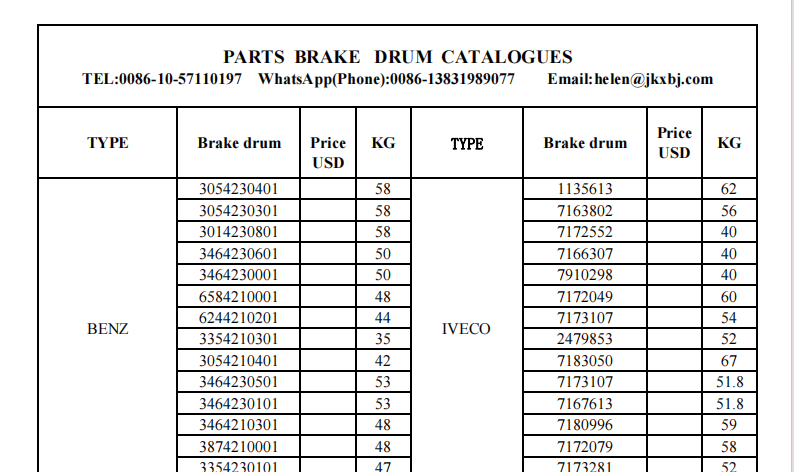Jul . 27, 2024 03:19 Back to list
Steps for Replacing Trailer Brake Drums and Ensuring Safe Towing Performance
Trailer Brake Drum Replacement A Comprehensive Guide
When it comes to trailer maintenance, brake drum replacement is one of the most critical tasks for ensuring safety on the road. Over time, brake drums wear down due to friction, heat, and environmental factors, which can lead to decreased braking efficiency and increased stopping distances. Regular inspections and timely replacements are essential for the longevity of your trailer and the safety of those on the road.
Understanding Brake Drums
Brake drums are part of the drum brake system, which uses friction to slow down or stop a trailer. The brake shoes press against the inner surface of the drum when the brakes are applied, creating the necessary friction to reduce speed. Given the amount of wear and tear they endure, brake drums typically need to be replaced every 30,000 to 70,000 miles, depending on driving conditions, load weight, and the quality of the braking components.
Signs You Need a Replacement
Before embarking on a replacement, it's crucial to recognize the signs that indicate your brake drums may need attention
1. Decreased Braking Performance If you notice that your trailer takes longer to stop or if the brakes feel less responsive, this could be a sign that your brake drums are worn out.
2. Vibration or Pulsation Unusual feedback through the brake pedal during braking could indicate an unevenly worn drum.
3. Cracks or Scoring Visually inspect the drums for any visible defects such as cracks, deep grooves, or scoring on the surface. These damages can significantly impair braking efficiency.
4. Increased Noise Grinding, squealing, or banging noises when applying the brakes can be indicative of worn brake components.
The Replacement Process
Replacing brake drums can be a straightforward process if you follow the right steps
. Here’s a general guidetrailer brake drum replacement

1. Gather Tools and Materials You’ll need a jack, jack stands, lug wrench, brake drum puller (if necessary), and new brake drums. Additionally, bring along any new brake shoes or hardware if you plan to replace those as well.
2. Elevate the Trailer Use the jack to lift the trailer and secure it with jack stands. Ensure that the trailer is stable before proceeding.
3. Remove Wheels Use the lug wrench to loosen and remove the wheel nuts. Take off the wheels to access the brake drum assembly.
4. Remove the Brake Drum Depending on your trailer, you may need to remove retaining bolts or use a brake drum puller. Once loose, slide the drum off the brake assembly.
5. Inspect Brake Components Before installing the new drum, inspect the brake shoes, hardware, and the wheel bearing for wear. Replace any damaged components.
6. Install the New Brake Drum Slide the new drum onto the hub, ensuring it is seated evenly. Reattach any retaining hardware.
7. Reinstall Wheels Place the wheel back onto the hub, tighten the lug nuts, and ensure they are secure.
8. Lower the Trailer Carefully lower the trailer back to the ground and remove the jack stands.
9. Test the Brakes Before hitting the road, test the brakes at low speeds to ensure everything is functioning correctly.
Final Thoughts
Regular maintenance of your trailer’s braking system is paramount for safe travels. While replacing brake drums may seem daunting, with the right tools and knowledge, it can be a manageable DIY task. However, if you are unsure or uncomfortable with any step of the process, remember that professional assistance is always available and can often save you time and ensure proper installation. Keeping up with regular maintenance not only enhances safety but also prolongs the lifespan of your trailer.
-
High-Quality Brake Drum Liza for Reliable Performance Drum Brake Drum & Brake Shoe Solutions
NewsJul.06,2025
-
High-Quality Brake Drum MAZ – Durable Drum Brake Drum & Brake Drum and Brake Shoe Solutions
NewsJul.05,2025
-
High-Quality Brake Drum Iveco - Durable Drum Brake Drum & Brake Shoe Solutions
NewsJul.05,2025
-
High-Quality Brake Drum MAZ – Durable Drum Brake Drum & Brake Drum and Brake Shoe Solutions
NewsJul.04,2025
-
Brake Drum Man - High-Quality Drum Brake Drums & Brake Shoes for Reliable Performance
NewsJun.24,2025
-
High-Quality Brake Drum Kamaz – Durable Drum Brake Drum & Brake Shoe Replacement
NewsJun.10,2025
